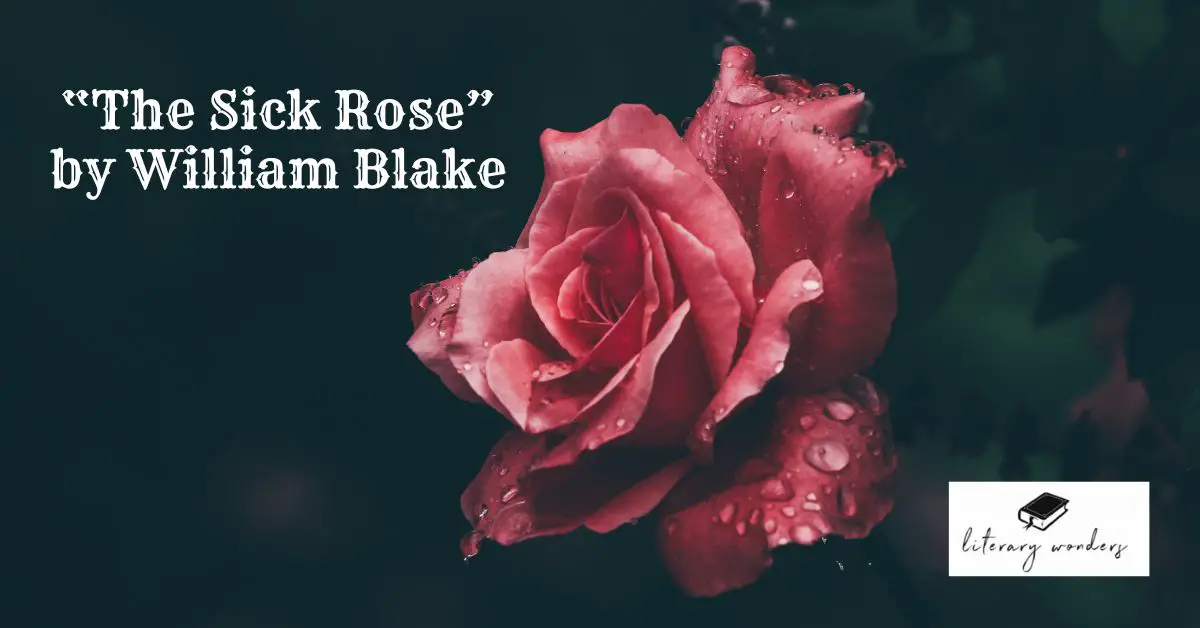Introduction
“The Sick Rose” by William Blake, a prosperous American author and poet, is a wonder of literature. Published in 1947 in Song of Experience, the poem explores the concepts of death and negativity. Painting a lifelike picture of a sick rose, the poet has captured the factors that caused severe damage to the rose. Depicted along the lines of sadness and woe, the poet has shared the heart-wrenching condition of the rose that hunts him. Also, he talks about the tiny insects that became the reason for her destruction and decay. Keeping rose as the center of the text; the speaker highlights the influence of love in one’s life.
Major Themes in “The Sick Rose”
Supremacy of love, the selfish nature of humanity, and the power of hatred are the central themes of the poem. The poem expresses the speaker’s sorrow over the problematic condition of a rose. He tries to make readers realize the pain and suffering that rose is enduring by calling her a sick rose. He takes pity on the tiny yet beautiful thing of beauty and wonders how a little worm became the reason for her downfall. Etched in woes and turmoil, the worm has snatched the colors and blessings of her life.
On a surface level, the poem talks about the sickness of a crimson rose that is hurt by an invisible power. On a deeper level, the poet portrays love as a dark and destructive force that makes lovers stand on the verge of destruction. Using powerful diction and a sympathetic tone, the poet presents rose as a pure and gorgeous being. Unfortunately, her innocence and purity are corrupted in the form of love. He compares love with a tiny invisible worm and wonders how it affects a person’s whole life.
Analysis of Literary and Poetic Elements in “The Sick Rose”
To add deeper meaning to the poem, William Blake has used various poetic elements in this poem that are as follows.
- Assonance
- Allegory
- Apostrophe
- Imagery
- Symbolism
- Personification
The first one is assonance. By repeating vowel sounds in a single line, he had made his words comprehendible for the audience. For instance, the sound of /o/ in “O Rose thou art sick” and /e/ sound in “And his dark secret love.” Allegory is yet another significant device that the poet has used to enhance the intended impact of the poem. The Writer has used allegory to describe abstract ideas and principles in the form of characters, events, and figures. The poet uses an allegoric expression in the opening line, informing the rose about her sickness.
William Blake has consciously used the language of personification to add more variety to his poem. The writer has personified rose throughout the poem.
The writer has also used an apostrophe in the poem. It is a literary device used to call someone or something from afar. The writer has used this powerful tool to call the rose a thing of misery, such as; “O Rose thou art sick. “Offering tangible portraying of certain emotions and feelings, William Blake has employed imagery to heighten the impact of the poem. Visual imagery is used, such as; “That flies in the night” and “Has found out thy bed.” Whereas auditory imagery is also applied in certain lines such as “In the howling storm.”
Furthermore, for a profound insight into his thoughts, the poet profusely uses symbolism to signify certain social ills and misfortunes of different people in society. Here, “crimson joy” symbolizes the beauty of that rose, and “thou art sick” represents her illness.
Poetic Devices Used in “The Sick Rose”
A few poetic devices are also used in the poem to shape the poem into a better structure. “The Sick Rose” is an eight-lined poem with two stanzas with each comprising four lines. To add musical quality to the poem, the ABAB rhyme scheme is followed diligently. The rhymes and melody are maintained using end rhyme in the poem, such as “joy/destroy” and “worm/storm.”
In-depth Analysis of “The Sick Rose” by William Blake
Stanza#1
In this stanza, the speaker addresses the rose directly and informs her about her sickness. While explaining the cause of her illness, the speaker states that she was hurt by an invisible worm that entered her life at night in the howling storm. Although the worm was hidden, the damage it has caused to the delicate rose is visible to the world.
Stanza#2
This stanza follows the same subject; the speaker elucidates how cleverly the worm discovered her bed of crimson joy. The choice of words suggests that the tiny warm became jealous of the unparalleled beauty and charms of the rose. Therefore, it aimed to turn her happiness into sorrow. Thus, with this unholy aim, he destroyed the pleasures of that innocent and beautiful rose.
Conclusion
To conclude, it can be rightly stated that love is a powerful emotion; it can control, reshape and redefine the course of someone’s life. Love has been portrayed as a negative force in this poem. The speaker wonders how it forces a rose to follow a path full of troubles and miseries. It is due to love’s selfish approach; the crimson rose was sickened and destroyed. This symbolic destruction may symbolize the devastation caused by hypocrisy, secrecy, deceit, and pain.
See Also:

